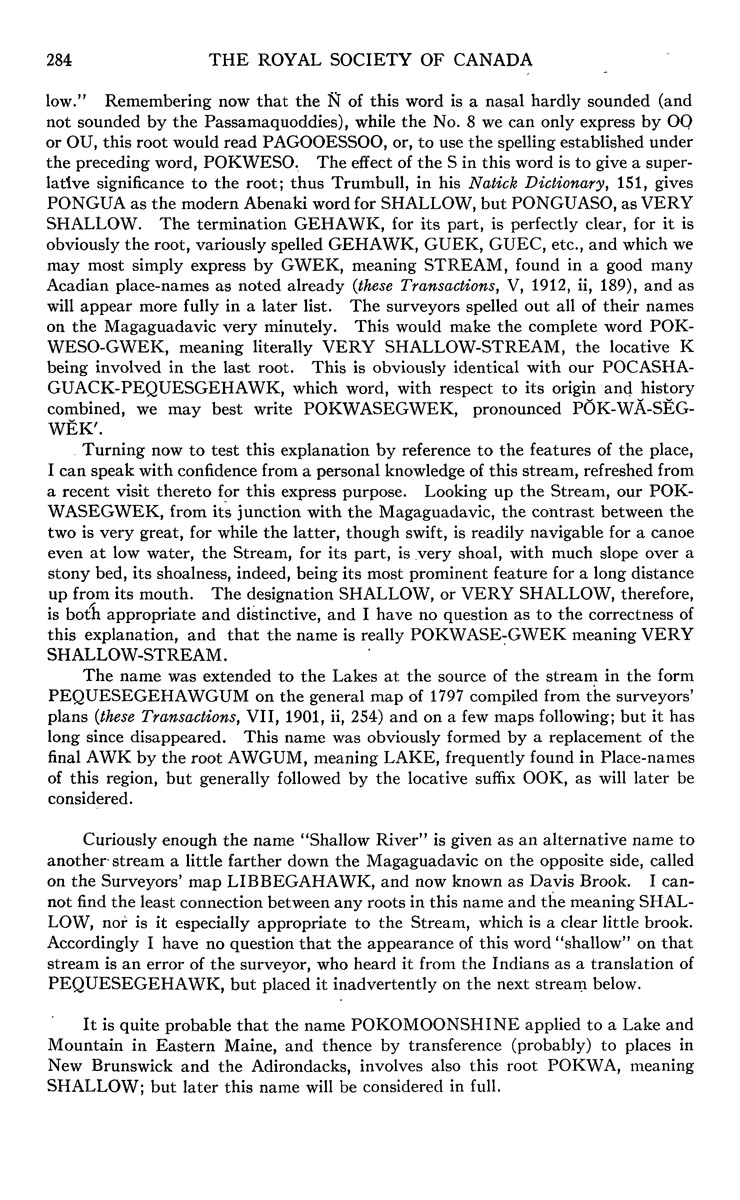284 THE ROYAL SOCIETY OF CANADA
low." Remembering now that the N of this word is a nasal hardly sounded (and
not sounded by the Passamaquoddies), while the No. 8 we can only express by OQ
or OU, this root would read PAGOOESSOO, or, to use the spelling established under
the preceding word, POKWESO. The effect of the S in this word is to give a super¬
lative significance to the root; thus Trumbull, in his Natick Dictionary, 151, gives
PONGUA as the modern Abenaki word for SHALLOW, but PONGUASO, as VERY
SHALLOW. The termination GEHAWK, for its part, is perfectly clear, for it is
obviously the root, variously spelled GEHAWK, GUEK, GUEC, etc., and which we
may most simply express by GWEK, meaning STREAM, found in a good many
Acadian place-names as noted already {these Transactions, V, 1912, ii, 189), and as
will appear more fully in a later list. The surveyors spelled out all of their names
on the Magaguadavic very minutely. This would make the complete word POK-
WESO-GWEK, meaning literally VERY SHALLOW-STREAM, the locative K
being involved in the last root. This is obviously identical with our POCASHA-
GUACK-PEQUESGEHAWK, which word, with respect to its origin and history
combined, we may best write POKWASEGWEK, pronounced POK-WA-SEG-
WEK'.
Turning now to test this explanation by reference to the features of the place,
I can speak with confidence from a personal knowledge of this stream, refreshed from
a recent visit thereto for this express purpose. Looking up the Stream, our POK¬
WASEGWEK, from its junction with the Magaguadavic, the contrast between the
two is very great, for while the latter, though swift, is readily navigable for a canoe
even at low water, the Stream, for its part, is very shoal, with much slope over a
stony bed, its shoalness, indeed, being its most prominent feature for a long distance
up from its mouth. The designation SHALLOW, or VERY SHALLOW, therefore,
is both appropriate and distinctive, and I have no question as to the correctness of
this explanation, and that the name is really POKWASE-GWEK meaning VERY
SHALLOW-STREAM.
The name was extended to the Lakes at the source of the stream in the form
PEQUESEGEHAWGUM on the general map of 1797 compiled from the surveyors'
plans {these Transactions, VII, 1901, ii, 254) and on a few maps following; but it has
long since disappeared. This name was obviously formed by a replacement of the
final AWK by the root AWGUM, meaning LAKE, frequently found in Place-names
of this region, but generally followed by the locative suffix OOK, as will later be
considered.
Curiously enough the name "Shallow River" is given as an alternative name to
another stream a little farther down the Magaguadavic on the opposite side, called
on the Surveyors' map LIBBEGAHAWK, and now known as Davis Brook. I can¬
not find the least connection between any roots in this name and the meaning SHAL¬
LOW, nor is it especially appropriate to the Stream, which is a clear little brook.
Accordingly I have no question that the appearance of this word "shallow" on that
stream is an error of the surveyor, who heard it from the Indians as a translation of
PEQUESEGEHAWK, but placed it inadvertently on the next stream below.
It is quite probable that the name POKOMOONSHINE applied to a Lake and
Mountain in Eastern Maine, and thence by transference (probably) to places in
New Brunswick and the Adirondacks, involves also this root POKWA, meaning
SHALLOW; but later this name will be considered in full.
|








